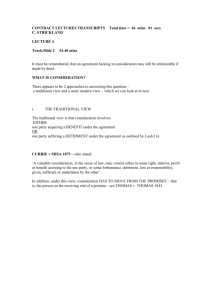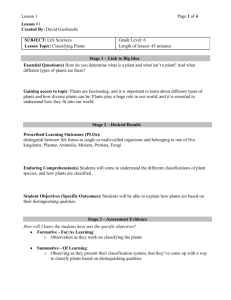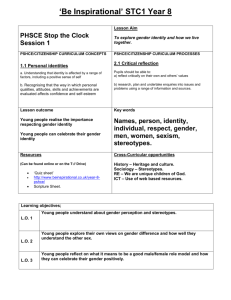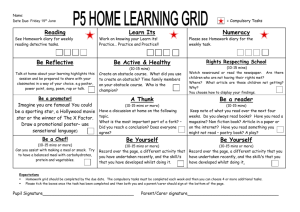Reading Tasks BEFORE READING Pre-Reading
advertisement
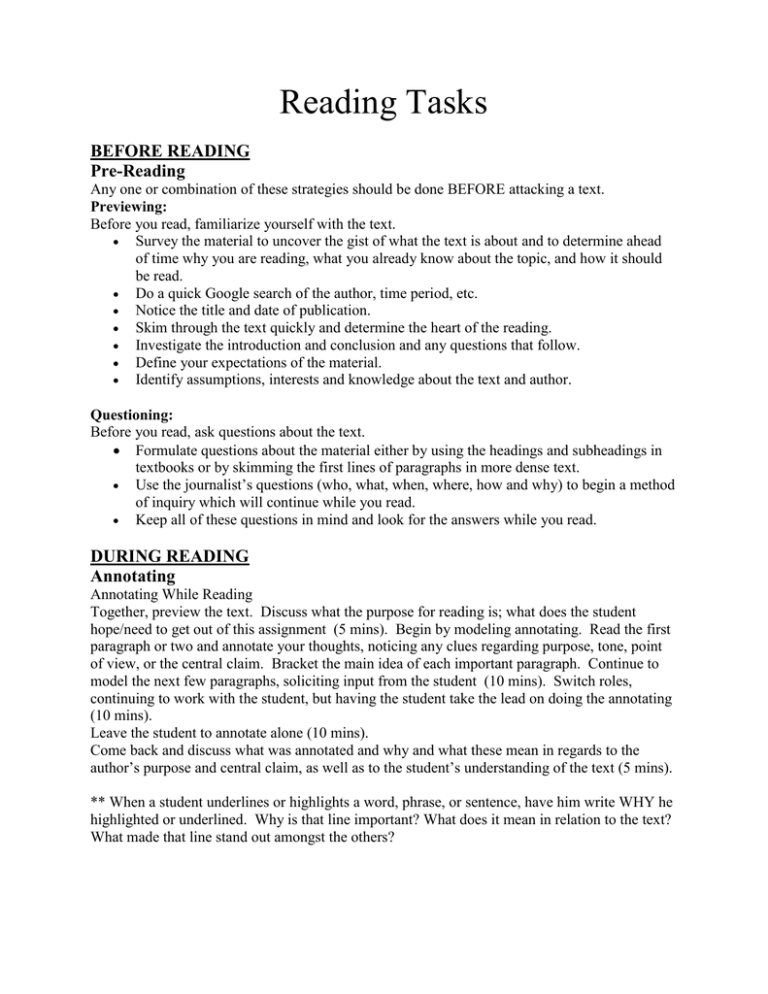
Reading Tasks BEFORE READING Pre-Reading Any one or combination of these strategies should be done BEFORE attacking a text. Previewing: Before you read, familiarize yourself with the text. Survey the material to uncover the gist of what the text is about and to determine ahead of time why you are reading, what you already know about the topic, and how it should be read. Do a quick Google search of the author, time period, etc. Notice the title and date of publication. Skim through the text quickly and determine the heart of the reading. Investigate the introduction and conclusion and any questions that follow. Define your expectations of the material. Identify assumptions, interests and knowledge about the text and author. Questioning: Before you read, ask questions about the text. Formulate questions about the material either by using the headings and subheadings in textbooks or by skimming the first lines of paragraphs in more dense text. Use the journalist’s questions (who, what, when, where, how and why) to begin a method of inquiry which will continue while you read. Keep all of these questions in mind and look for the answers while you read. DURING READING Annotating Annotating While Reading Together, preview the text. Discuss what the purpose for reading is; what does the student hope/need to get out of this assignment (5 mins). Begin by modeling annotating. Read the first paragraph or two and annotate your thoughts, noticing any clues regarding purpose, tone, point of view, or the central claim. Bracket the main idea of each important paragraph. Continue to model the next few paragraphs, soliciting input from the student (10 mins). Switch roles, continuing to work with the student, but having the student take the lead on doing the annotating (10 mins). Leave the student to annotate alone (10 mins). Come back and discuss what was annotated and why and what these mean in regards to the author’s purpose and central claim, as well as to the student’s understanding of the text (5 mins). ** When a student underlines or highlights a word, phrase, or sentence, have him write WHY he highlighted or underlined. Why is that line important? What does it mean in relation to the text? What made that line stand out amongst the others? AFTER READING Simple Reader Response Upon completion of reading an essay or a portion of one, ask the following questions: What do you think? How did it make you feel? Did it remind you of anything? What did it make you think about? What did the essay mean to you? What do you think the author was trying to say? You can use any of these questions as a jumping off point for conversation about the text. Spend five minutes honoring a student’s personal reaction before diving in to the work of deep analysis. Notice and Focus This task guides students to dwell longer with the text before deciding what the text means. What do you notice? What do you find most interesting? What do you find most strange? What do you find most revealing? o Step 1: Cast a wide net by listing details you notice. Go longer than you normally would. o Step 2: Focus inside what you noticed. Rank the various features of your subject you have noticed. Answer the question “What details are most interesting, or significant or revealing or strange?” The reason you rely on interesting or one of the other suggested words is that these will help to turn off the like/dislike switch and replace it with a more analytical perspective. o Step 3: Say why three things you select struck you as the most interesting (or revealing or significant or strange). Saying why will trigger interpretive leaps to the possible meaning of whatever you find most interesting in you observations. Taken from: Writing Analytically by David Rosenwasser and Jill Stephen Evidence to Support the Central Claim If the student has already read the text, have him/her discuss the central claim (5-10 mins). Have the student go back and find specific lines from the text to support that point. The student should highlight, underline, or take notes on these lines (15-20 mins). Discuss with the student how these lines prove the author’s point (10 mins). Word Choice and Tone Words One of the ways in which an author tries to get her point across, expresses her point of view, or tries to persuade the reader is by the use of specific words. After reading an essay or a section of one, have the student look through the text to find words that indicate the author’s bias/point of view. Have the student jot down their first ideas of what the text is about. Have the student revisit/reread/skim the text for words that give them a strong emotion or a clear image in his mind. They can make a list or underline/highlight the words. Then have the student decide which words fit together, how they do so, and what they say about the text.


